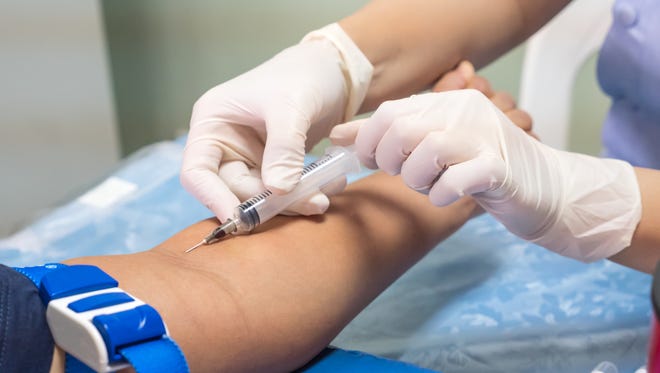Veins in the Arm Blood Draw

Vein size is not something that a person typically thinks about until they have blood drawn for lab work or for a blood donation and — ouch — it hurts. Instead of just pain from the needle poke, pain also can come from an inserted needle that is larger than the vein itself.
This can be particularly true for people who have smaller veins. In fact, vein size can vary from person to person.
"Some people just have smaller veins than others," said Lavanya Namballa, M.D., a doctor in internal medicine at Renown Medical Group. "A vein can range in size from about one millimeter to one-and-half centimeters in diameter. There are genetic mutations that can cause changes in vein size as well, such as cutaneous mucosal venous malformations."
Of course, vein size is not the only factor when it comes to blood draws. Issues that can make draws more challenging include rolling veins, which are veins that roll from side to side, and lack of hydration, which can prevent veins from plumping up, according to Wynter Phoenix, M.D., a general surgeon with Northern Nevada Medical Group.
"Moreover, veins that spasm, or clamp down easily, make it harder to draw blood," he said.
In fact, a patient can experience an issue like a vein spasm as discomfort or tenderness, he said. And, because of the challenge of locating the best veins for blood draws, phlebotomists typically use the forearm.
The veins there are usually slightly larger than in the hands, he said. And while the veins in the forearms may not always be as visible as the ones in the hands, the ones in the forearms usually have more tissue surrounding them.
"Veins get larger the closer to the center of the body you get," he explained.
Choosing a Butterfly Needle
People who know they have smaller veins may want to request the use of a butterfly needle during a blood draw. This is a short, straight, very thin hollow needle that can be helpful, according to Namballa.
From the patient side it can help to decrease pain, but from the phlebotomist perspective it can help when veins are particularly hard to find, she said. Of course, new techniques are already in use to make vein location easier.
"Ultrasound-guided insertion of the needles is more commonly practiced now and many care providers are being trained to use this technique," she said.
Patients who are concerned about blood draws may want to drink plenty of water beforehand. This is because hydration can help to expand the vascularity system of both the arteries and the veins, said Phoenix.
He also added that keeping warm the "the area where the veins of interest are" can help to temporarily plump up the vein size, which can be advantageous during a blood draw.
What's Vein Size Got To Do With It?
Small vein size may have ties to some vein issues, according to Namballa. For example, those unsightly varicose and spider veins that can make women cringe can be more common in patients who have smaller veins, she said. Also, individuals who have small cutaneous veins, or veins that appear close to the skin's surface, may have more leg symptoms, like pain or leg swelling, than people with larger cutaneous veins, she added. The size of a vein can also affect the amount of bleeding someone has, especially in people who with some connective tissue disorders.
"[However], most problems with veins involve the skin having a bluish discoloration and are more of cosmetic issue than a health one," she noted.
It also can be important to know that the ability of blood to flow through the veins is affected more by other factors than simply vein size, according to Phoenix. For example, how much someone stands or sits all day, how mobile they are and how much they can access their muscles to help pump venous blood forward can affect the flow of blood in their body, he said.
"It is not recognized that the size of the veins affects general health," said Phoenix. "Literature and experience demonstrates that the 'flow dynamics' has the most important function, that is, how well the blood circulates appropriately in the veins to get back to the heart."
Source: https://www.rgj.com/story/life/wellness/2018/03/28/ouch-challenging-factors-during-blood-draws/467214002/
0 Response to "Veins in the Arm Blood Draw"
Postar um comentário